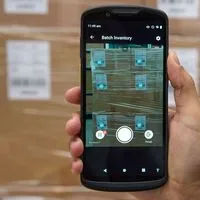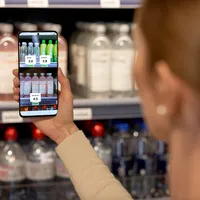6 Smart, Automated Data Capture Methods to Drive Digital Transformation
| Products & Solutions
:format(jpeg))
In the words of LinkedIn’s Executive Chairman, Jeffrey Weiner: “Data really powers everything that we do.”
But for data to power everything you do, you first have to collect it. Digital assets (such as the LinkedIn website) generate data almost effortlessly. For most companies, though, this is only part of the story.
To drive digital transformation and data democratization, companies need data relating not just to digital but also tangible assets – such as inventory or equipment.
:format(jpeg))
And capturing this data is much harder. In this blog, we explore automated data capture – also known as smart data capture. And we dive into the top six techniques companies can use to capture data on tangible assets in an efficient, accurate, repeatable and scalable manner.
Advances in computer vision – a specific field of artificial intelligence – now enable any smart device with a camera to “see” and interpret the world around it.
There are plenty of accessible automated data capture methods, right down to no-code applications for low-end consumer smartphones. Businesses of every size can use these to drive digital transformation.
What is data capture and why do we need it?
Data capture is the process of collecting information from the physical world and converting it into a form a computer can read and use. From inventory checks and parcel redirections to compliant medication administration, data capture is the beginning of many information management processes.
When you get data capture right, the returns are substantial. For example, businesses that capture and aggregate data intelligently can grow revenue by over 30%, according to research by IDC.
:format(jpeg))
Why do businesses need automated data capture methods?
In many businesses, the technology and processes used to capture data from physical assets haven’t evolved in decades. In the worst-case scenario, employees still use pen and paper.
Other businesses have partly automated processes, but still rely heavily on elements of manual data capture. The process of scanning a batch of barcodes when receiving a delivery is a good example.
Usually, this relies on a frontline worker aiming carefully at each individual code and pressing a button.This can equate to scanning hundreds or even thousands of individual barcodes a day. It’s inefficient, prone to error and tedious for employees.

More about automated data capture
Smart data capture empowers businesses to capture and access real-time data using any smart device with a camera. It can be deployed into any ecosystem.
6 methods of smart, automated data capture
1. Barcode and QR code scanning
Barcodes themselves are not an automated data capture method. But the techniques used to extract information from them can be.
Barcodes were invented almost exactly 75 years ago, in 1948. They’re ubiquitous in retail, logistics, transport, manufacturing, healthcare and many other industries. There are also many types of barcodes, including QR codes.
Today, there are much smarter ways to extract the encoded information from a barcode than pointing a specialized scanner at a single code and pressing a button.
Smart barcode scanning applications can detect and scan any barcodes within the field of view of a camera. Some also include advanced features such as augmented reality. These can display actionable, real-time SKU-level insights on the device screen.
This automated data capture technique streamlines workflows. For example, you can batch scan an entire delivery at once, identify markdowns at a glance or instantly pick a single product out of many.
2. Optical Character Recognition (OCR) and Intelligent Character Recognition (ICR)
Optical Character Recognition (OCR) and Intelligent Character Recognition (ICR) convert typed or handwritten text, numerals or symbols into a machine-readable form. OCR converts typed characters while ICR converts handwritten characters.
As handwriting varies more than printed text, ICR is generally less accurate than OCR – although it is continually improving.
Probably the most well-known use of this automated data capture technique is scanning and digitizing large volumes of paper documents – in, for example, banking and legal industries. However, it’s also widely used in applications that extract short amounts of text or alphanumeric codes from a camera feed.
For example, OCR can automate price and expiry date checks in retail by “reading” information on price and product labels.
:format(jpeg))
It is also used to capture data such as VIN numbers (vehicle identification numbers – a 17-digit unique identity number stamped into the vehicle chassis of a car), or lot numbers (a unique code manufacturers assign to a batch of goods produced in the same run).
In sectors such as automotive, insurance, car rental and manufacturing, automated data capture of labels and codes speeds up processes, reduces error and minimizes the risk of fraud.
3. Intelligent Document Recognition (IDR)
Intelligent document recognition (IDR) software combines OCR/ICR with other fields of artificial intelligence to take automated data capture techniques a step further. It not only digitizes printed documents, but automatically classifies, processes and stores data extracted from them.
IDR reduces or eliminates time spent searching for relevant information in documents such as invoices, order forms, medical records, mortgage applications and insurance documents.
It improves employee experience by reducing the time spent on what is typically a boring, unattractive task. Employees are also freed up to spend time on activities that add more value, and have actionable insights immediately to hand for quick and distributed decision making.
:format(jpeg))
4. ID Scanning
The need for compliant ID checks has escalated in recent years – from airport security demands to the rise in age-restricted deliveries.
Luckily, the technology to automate ID verification has evolved too. Data from ID cards, visa certificates, passports or driving licenses can now easily be captured through the lens of a device camera using ID scanning software.
IDs come in a wide variety of different formats. ID scanning software uses a variety of automated data capture techniques to decode visual inspection codes, machine-readable zones (MRZ) or PDF417 barcodes.
The data can then be automatically checked to:
- Verify authenticity.
- Verify ID data matches other criteria (for example, age verification for age-restricted goods).
- Check the ID expiry date, type, layout and other document properties.
- Cross-check ID data against other databases.
Automated ID scanning replaces an error-prone and time-consuming manual task with a faster, more reliable way to verify identities or authenticate documents.
Businesses can detect potential fraud and fake IDs and create an audit trail. This helps them to avoid hefty fines and trading penalties.
:format(jpeg))
5. Object Recognition
Object recognition is a technique that recognizes physical characteristics to establish the presence of or analyze the features of a physical object or person.
Object recognition is a broad field of automated data capture with almost unlimited use cases. To give just two examples, airport operations now use facial recognition software to process passenger passports quickly. And retailers can use product recognition to identify gaps on shelves and for planogram compliance.
6. Multimodal Automated Data Capture Techniques
Multimodal automated data capture uses more than one smart data capture technique to collect data and complete a task.
For example, in some ID verification scenarios, OCR to decode text and barcode scanning of PDF417 barcodes are analyzed simultaneously to authenticate an ID document.
Multimodal data capture is also used in retail. Autonomous robots or mobile devices are deployed to scan shelves. OCR, object recognition and barcode scanning then collectively decode SKU barcodes, text on price labels and objects on shelf.
This is then compared to an ERP system. Store associates can be given real-time, accurate guidance on updates. It increases the efficiency of stock replenishment and planogram compliance. The move from thinking of data capture as the point-in-time process of capturing a single type of data to a multimodal approach is one of the biggest trends in data capture today.
:format(jpeg))
Automated data capture methods for digital transformation
True data intelligence begins with efficient and timely data capture. It is the lifeblood of any digital business transformation strategy.
Automated or smart data capture is deployable on any system or application and uses multiple techniques in new and innovative ways. It empowers businesses of all sizes to capture and access real-time data.
Smart data capture is doing more than simply speeding up processes. It’s fundamentally changing the way we live and work – for the better.

How smart data capture works
Discover how smart data capture delivers superior customer experiences and business outcomes.